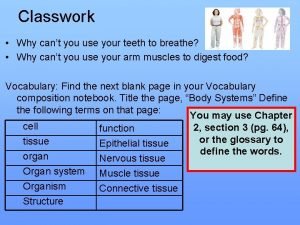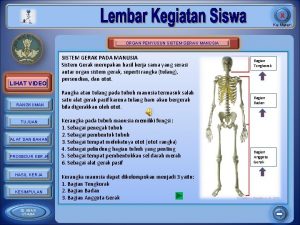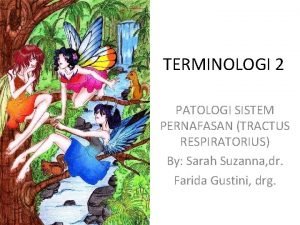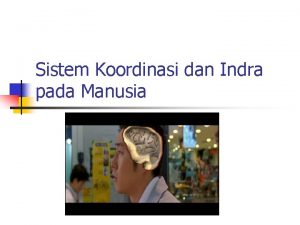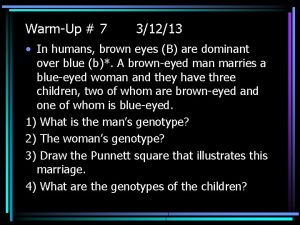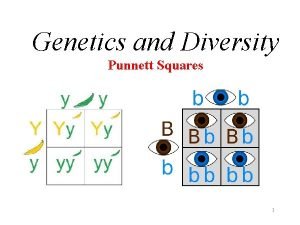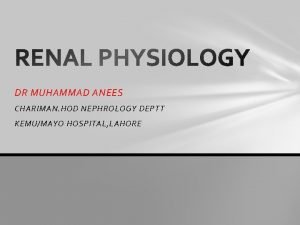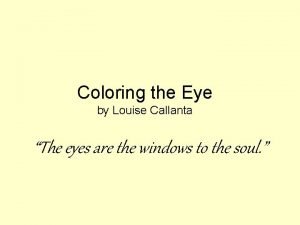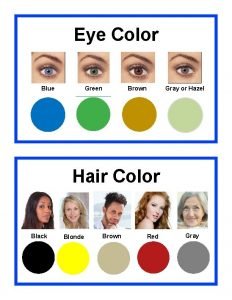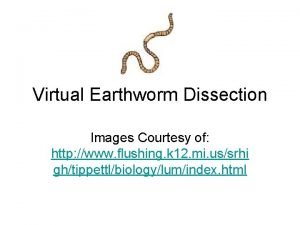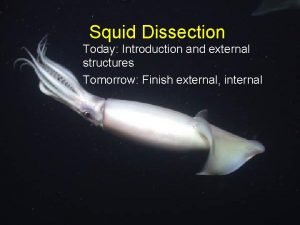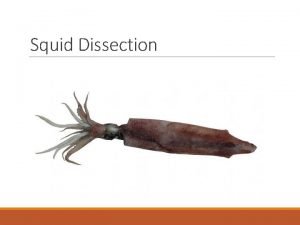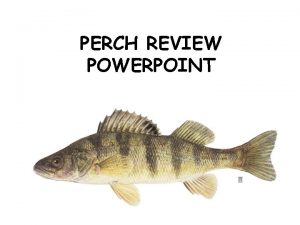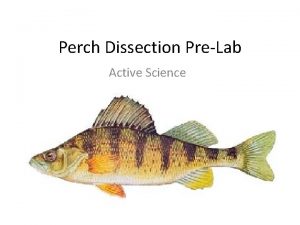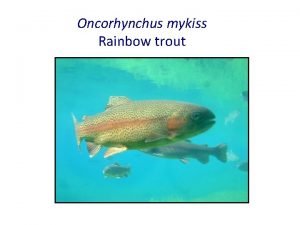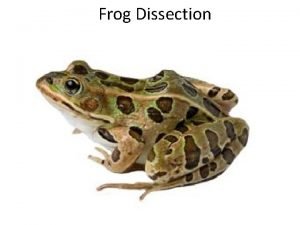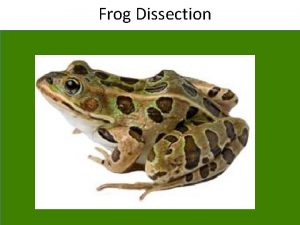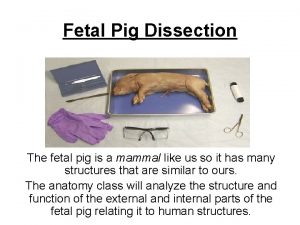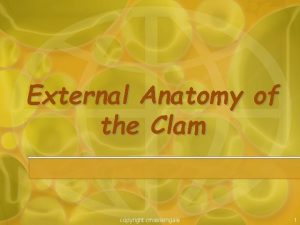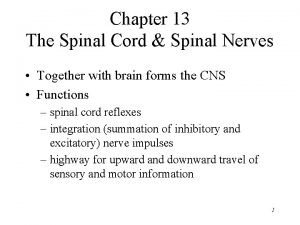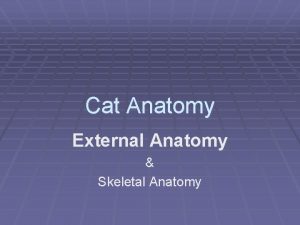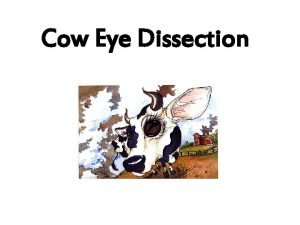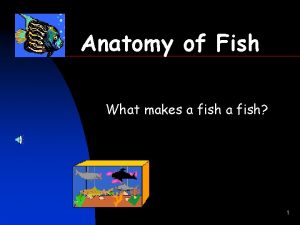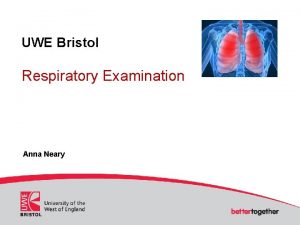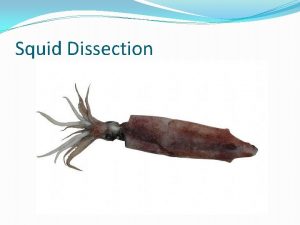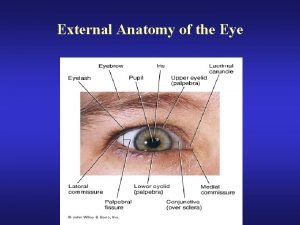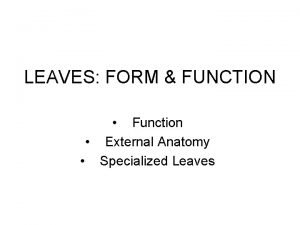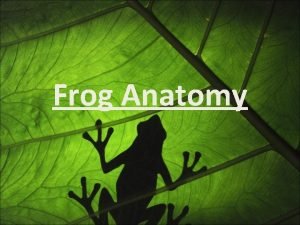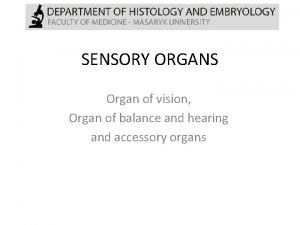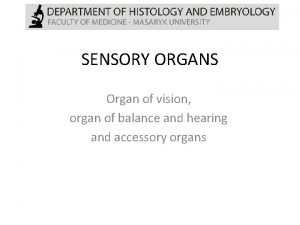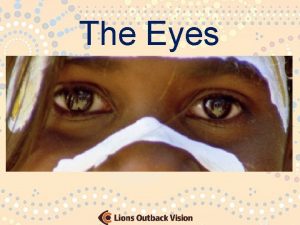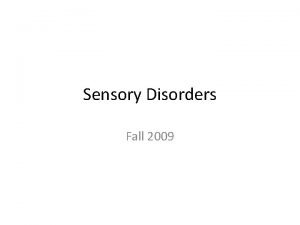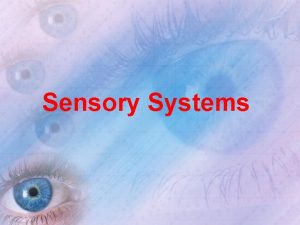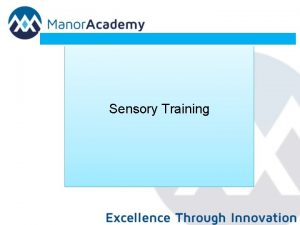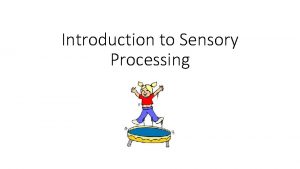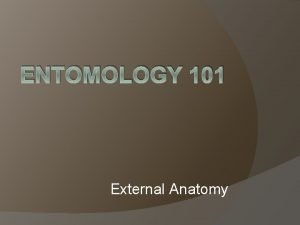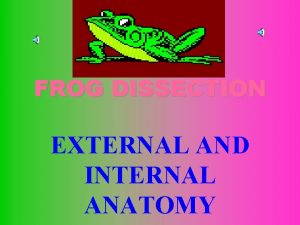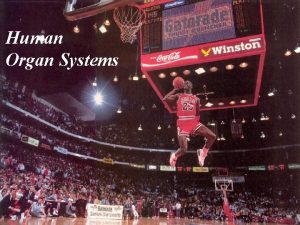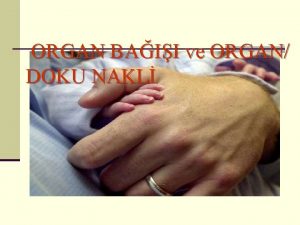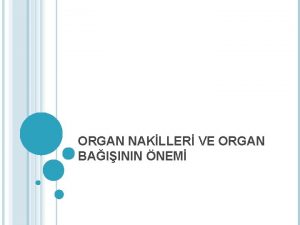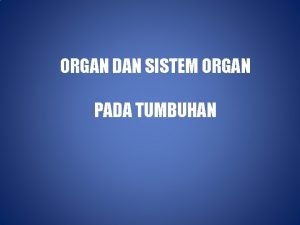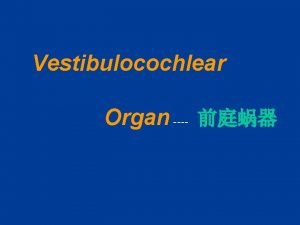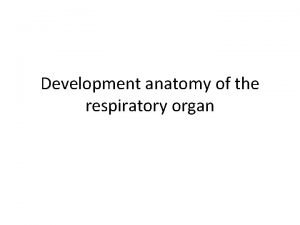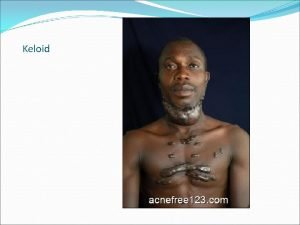Eyes External Anatomy l Sensory Organ for vision





























































- Slides: 61

Eyes

External Anatomy l Sensory Organ for vision -Situated in bony, orbital cavity for protection – Eyelids= shades that add protection form injury, strong light , dust – Eyelashes= hairs to filter dust & dirt

External Anatomy

l Limbus – border b/t the cornea & sclera l Palpebral fissures – elliptical open space b/t lids l Canthus- corners of the eye where the lids meet, inner & outer l Caruncle – sm. Fleshy mass containing sebaceous glands at inner canthus

l Within the upper eyelid – – Tarsal plates, connective tissue gives upper lid shape Meibomian glands, in the plates, lubricate the lids, stops overflow of tears, airtight seal when lids closed

l Exposed part of the eye – Conjunctiva, folded envelope b/t eyelids & eyeball thin mucous membrane, transparent protective covering of the exposed part of the eye. l Palpebral conjunctiva lines the lids, is clear but has sm. bld. Vessels l Bulbar conjunctiva is over eyeball, white sclera show through, merges at limbus with cornea l

l Cornea pupil – clear, covers & protects iris &


l Lacrimal apparatus – irrigates conjunctiva & cornea – 3 parts A. B. C. Lacrimal gland, upper, outer corner of eye = tears Puncta= inner canthus, tear drainage Nasolacrimal duct= allows tears to drain from puncta to nasolacrimal sac. Tears then empty into the inferior meatus of the nose


Extraoccular muscles l 6 muscles – – – Attach eyeball to orbit Straight and rotary movement Four straight muscles 1. 2. 3. 4. Superior rectus Inferior rectus Lateral rectus Medial rectus

l Two slanting/ oblique muscles 5. Superior 6. Inferior Humans have a Binocular, single – image visual system – Eyes normally move as a pair

• Eye movement stimulated by Cranial Nerves • III Oculomotor • IV Trochlear • VI Abducens



Internal Anatomy l The eye has 3 layers, the outer & inner layer can be viewed using opthalmascope 1. Sclera (outer layer) tough, protective, white covering connects with the Ø Cornea – transparent, protects pupil & iris – helps focus light on retina

2. Middle layer Ø Choroid – dark pigmentation to prevent internal light reflection, supplies bld. to retina Ø Pupil – PERRLA Ø Lens – biconvex disc, transparent, thickness controlled by ciliary body, bulges = near; flattens = distant Ø Anterior chamber – posterior to cornea, anterior to iris & lens, has aqueous humor supplies nutrients & drains wastes

3. Inner layer – Retina – visual receptive layer – light waves changed to nerve impulses v Retinal structures v v Optic disc – retinal fibers meet & form optic nerve, nasal side of retina, creamy yellow orange to pink, round or oval shape, physiologic cup inside the disc for bld. vessels to enter & exit Retina vessels – paired arteries & veins

Macula – temporal side of fundus, darker pigmented region, surround the fovea centralis v Fovea Centralis- area of sharpest & keenest vision, Very sensitive to light v


Visual Pathways & Fields Objects reflect light l Rays refracted by cornea, aqueous humor, lens, vitreous body and onto retina. l Light stimulus is changed to nerve impulses, travel thru optic nerve to visual cortex in occipital lobe l Image on retina is upside down & reversed. At the optic chiasm retinal fibers cross over. Right side of brain looks at left side of world. l


Visual reflexes l Pupillary light reflex – bright light = constriction – Direct light reflex – Consensual light reflex Fixation – ability to track an object & keep image on the fovea, can be impaired by drugs, alcohol, fatigue & inattention l Accomodation – for near vision = pupil constriction & convergence of eyes l



Subjective data l Vision difficulty l Pain l Strabismus, diplopia l Redness, swelling l Watering, discharge l Past history ocular problems l Glaucoma

l Glasses/ contacts l Medications l Vision loss- coping mechanisms l Self–care behaviors

Objective data The Physical Exam l Preparation – Position- sitting, head at eye level l Equipment – Snellen eye chart- visual acuity – Handheld visual screener-near vision – Opaque card – Penlight – Applicator stick – Ophthalmoscope

Test visual acuity Snellen eye chart l l l Stand 20 ft. from chart Glasses / contacts (Document ) Remove eye wear, retest Normal visual acuity is 20/20 – top # is distance person is standing from the chart Vision 20/30 refer to opthalmologist or optometrist If unable to see largest letters, move to 10 feet – record as 10/200

Test for near vision l Vision screener l People > 40 yrs or difficulty reading l Test each eye with glasses l Hold card 14 in. from eyes l Normal result 14 / 14 l Test using any available reading material if no card available

l Presbyopia is a normal physiological change in near vision occurs with aging = note if the person moves the card farther away

Test visual fields Confrontation test l Compares peripheral vision with a tester who has normal peripheral vision l 2 ft. apart, eye level l Tester & client cover opposite eyes l Tester advances finger in the periphery – Superiorly ( 50 degrees ) – Inferiorly ( 70 degrees ) – Temporally ( 90 degrees )


Inspect Extraoccular Muscle Function l Corneal light reflex l Cover test l Diagnostic positions test – 6 Cardinal Positions of Gaze

Inspect Extraocular Muscle Function l Corneal Light Reflex ( The Hirschberg Test) assesses parallel eye alignment – Shine light toward person’s eyes – Tell to stare directly ahead – Hold light 12 in. away – Light should reflect on both corneas in same spot

l Cover Test- detects deviated alignment – Stare straight at examiner’s nose – Cover 1 eye of the person being examined with opaque card – Normally the uncovered eye should maintain a steady, fixed gaze – Covered eye- should stare straight ahead when covered & then uncovered. If muscle weakness exists the covered eye will relax and then jump to fixed position when uncovered. .

Diagnostic Positions Test l 6 cardinal positions of gaze – – Determines muscle weakness during movement – Person must hold head steady – Follow movement of object (examiner’s finger, pen etc) only with eyes – Hold object 12 in. from person – Move thru each position, clockwise, hold , then back to center – Normal response= parallel tracking with both eyes


l During this test be aware of Nystagmus-fine jerky movement seen around the iris l Mild nystagmus in extreme lateral gaze is normal but normal in any other position

Inspect External Structures l l l General – movement & facial expression (squinting? ) Eyebrows – 2(bilateral), symmetrical (look the same; move the same) Eyelids & Lashes – present, approximate when closed, no redness, swelling, discharge, lesions? Eyeballs- alignment, ? Protrusion? Sunken? Conjunctiva & Sclera – moist, glossy, clear, white sclera

l Eversion of the upper eyelid FYI – we will not do this examine in lab see pg. 312 for technique – usually done for complaint of eye pain due to foreign body



l Lacrimal Apparatus – Person looks down – Using thumbs, slide outer part of upper lid along bony orbit – Note redness or swelling – Press index finger against lacrimal sac at inner canthus – Normal response is slight eversion of lower lid, no tearing or discharge


Anterior Eyeball Structures l Cornea & lens l Iris & pupil – Size & shape – Pupillary light reflex – Accommodation

Cornea & Lens l Shine light from side across cornea l Check smoothness, clarity l Normally no opacities

Iris and Pupil l Iris = flat, round, regular, even color bilaterally. l Pupils = PERRLA – Resting size norm = 3 -5 mm – 5% population have pupils of 2 diff. Sizes called Anisocoria

l Pupillary Light Reflex – Darken room – Person gazes straight ahead – Advance light from the side Direct light reflex l Consensual light reflex l – Measure pupil size before & after light reflex – Measurement R 3/1 L 3/1 =both pupils measure 3 mm in resting state & 1 mm with light

l Accomodation – focus on distant object -dilatation of pupils – Shift gaze to near object – pupils constrict & converge l Record the normal response to these tests as l PERRLA = Pupils Equal, Round, React to Light and Accomodation

Ocular Fundus (internal surface of retina) l Use Opthalmoscope- try keeping both eyes open- practice looking at a ring on your finger. Become familiar with the instrument before you examine your partner’s eyes

l Diopter of opthalmoscope – Black numbers = +diopter, focus on near objects – Red numbers = - diopter, focus on further objects l Use ophthalmoscope in darkened room = dilates pupils

l Remove examiner’s and person’s eyeglasses but contact lenses may be left in. l Select lg. White aperture light l Person should focus on a distant object and try & remain still l Examiner hold ophthalmoscope in Right hand to right eye to eamine person’s right eye

l Begin 10 in away at 150 lateral angle & advance l Keep sight of red reflex l Adjust lens to +6 as you advance till your foreheads almost touch. Adjust diopter to focus. – Normal vision set at 0. Nearsighted use red #s. Farsighted use black.


Retinal background l Light – dark red normally l Note Lesions – Size, shape, color, distribution

Macula & Fovea Centralis l Last in Funduscopic exam – 1 DD in size – Darker than rest of fundus – Foveal light reflex – Exam last


Retinal Vessels Arteries Veins COLOR Light red Dark red SIZE Smaller 2/3 to 4/5 diam. Of veins Bright Larger LIGHT REFLEX Inconspicuous absent

Read Aging & Developmental Considerations Review Abnormalities of the Eyes

3 most common causes of decreased visual functioning in the older adult l Cataract (lens opacity) l Glaucoma (increased ocular pressure) = loss of peripheral vision l Macular degeneration (breakdown of cells in the macula lutea) = loss of central vision
 Cell tissue organ organ system organism
Cell tissue organ organ system organism Tissue are grouped together to form various
Tissue are grouped together to form various 3 organ penyusun sistem gerak manusia
3 organ penyusun sistem gerak manusia Organ and organ system
Organ and organ system Tractus respiratorius
Tractus respiratorius Organ penyusun sistem koordinasi pada manusia
Organ penyusun sistem koordinasi pada manusia Brown eyes are dominant to blue eyes
Brown eyes are dominant to blue eyes Blue eyed father brown eyed mother
Blue eyed father brown eyed mother Pf
Pf Two blue eyed parents brown eyed child
Two blue eyed parents brown eyed child Blue vs gray eyes
Blue vs gray eyes Superior conjunctival fornix
Superior conjunctival fornix External-external trips
External-external trips Cs766
Cs766 Earthworm images
Earthworm images External structure of squid
External structure of squid Squid kingdoms
Squid kingdoms Fish reproductive system
Fish reproductive system Perch external anatomy
Perch external anatomy Trout internal anatomy
Trout internal anatomy Rainbow trout internal organ diagram
Rainbow trout internal organ diagram Dissecting tray function
Dissecting tray function Frog dissection external anatomy
Frog dissection external anatomy Frog
Frog Frog external parts
Frog external parts Swine external anatomy
Swine external anatomy Inside of a clam diagram
Inside of a clam diagram Spinal cord cover
Spinal cord cover Cat rump
Cat rump External anatomy of stem
External anatomy of stem Left atrium sheep heart
Left atrium sheep heart Optic disc of cow eye
Optic disc of cow eye Puffer fish anatomy
Puffer fish anatomy Student lab virtual earthworm dissection answers
Student lab virtual earthworm dissection answers Tactile.fremitus
Tactile.fremitus Squid taxonomy
Squid taxonomy Superior nasal meatus
Superior nasal meatus Frog external anatomy
Frog external anatomy Parts of the external eye diagram
Parts of the external eye diagram External anatomy of a rat
External anatomy of a rat Gastric cecae
Gastric cecae Pinnately compound leaf
Pinnately compound leaf External nares of a frog
External nares of a frog Oncorhynchus mykiss
Oncorhynchus mykiss Iso 22301 utbildning
Iso 22301 utbildning Typiska novell drag
Typiska novell drag Nationell inriktning för artificiell intelligens
Nationell inriktning för artificiell intelligens Returpilarna
Returpilarna Shingelfrisyren
Shingelfrisyren En lathund för arbete med kontinuitetshantering
En lathund för arbete med kontinuitetshantering Underlag för särskild löneskatt på pensionskostnader
Underlag för särskild löneskatt på pensionskostnader Personlig tidbok
Personlig tidbok A gastrica
A gastrica Densitet vatten
Densitet vatten Datorkunskap för nybörjare
Datorkunskap för nybörjare Stig kerman
Stig kerman Att skriva debattartikel
Att skriva debattartikel För och nackdelar med firo
För och nackdelar med firo Nyckelkompetenser för livslångt lärande
Nyckelkompetenser för livslångt lärande Påbyggnader för flakfordon
Påbyggnader för flakfordon Vätsketryck formel
Vätsketryck formel Publik sektor
Publik sektor
